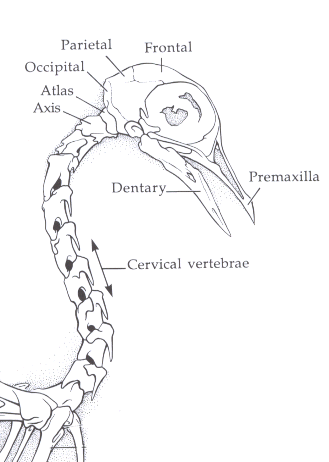BrokenWing Chronicles
The Neck
The neck is another interesting area of the bird. Some birds have very long necks (think of the graceful swan, the goose and the flamingo). Humans have seven cervical (neck) vertebrae, which are the bones that are surround the spinal cord. Birds have between 11 to 25 cervical vertebrae, which varies with the length of the neck. Nature designed the bird so that the minimum length of the neck is long enough to enable the bird to reach the uropygeal gland (also called the preen gland, found at the base of the tail in species that have one) so that it can properly preen. The neck is usually proportional to the length of the legs. So, long legs are generally found with a long necked bird, which enables the bill to reach the ground. But a long neck doesn't have to accompany long legs (think of the goose). The shortest necks are found in the small passerine birds. In the neck, the esophagus moves from the center of the mouth to the right side. This is the reason that some people recommend feeding baby birds from the left side of the beak, with the syringe pointing to the right, although, in reality, it shouldn't matter which side of the beak a baby bird is fed from. The trachea (windpipe) also curves to the right in the neck. Also found in the neck are the paired jugular veins, with the right jugular usually being much larger. Avian vets may use the right jugular vein to draw a blood sample.
Generally, the neck is carried in a double curve, which forms an "S". Since the forelimb has been completely committed to flight in birds (as a group, although some birds, such as the emu and ostrich cannot fly), the bill has assumed the ability to perform many functions normally carried out by the mammalian forelimb, such as grooming and nest building. Anyone that owns a parrot knows that the beak is used, along with the tongue, to explore its environment. A person unfamiliar with birds may pull away when a bird that has had a hand extended to it to be picked up, reaches beak-first towards the hand prior to stepping aboard. The novice may incorrectly assume that the bird is going to bite him, but the bird is just using the beak to test the waters, so to speak, prior to stepping up.
Since the neck forms an "S" curve, it protrudes forward in the front, above the level of the crop. Often, this may be mistaken for a tumor or abnormality in the neck, especially when the crop is empty and the bird is sitting comfortably. Because the neck has more vertebrae than a human's and mammal's, the avian neck is extremely flexible, mobile and strong. We've all seen how easily a owl can turn its head so much farther around than we can. When a bird is comfortably restrained by an avian vet, the head and/or neck is held. The neck is considered one of the strongest parts of a bird's body, and it is almost impossible to injure a bird by holding it by the neck (as long as the windpipe is not closed off), let alone break its neck, when it is properly restrained. Often, people think, when they pick up a limp, dead bird, that it must have broken its neck, because the neck is so limber. It rarely is the cause of death. Birds that fly into a window or other solid structure may die, often of a concussion or other trauma, but in all my years of practice, I have only seen two birds with fractures of the cervical vertebrae.
In the front part of the neck of parrots, the crop (or ingluvies) is found. It is actually an outpouching of the esophagus, the tube that carries food from the mouth to the stomach. Many people think that all birds have a crop, but some do not, including the gull and penguin. In the parrot, it is oriented transversely across the neck. In pigeons and doves, the lining of the crop is shed when they are feeding babies, for the first few days. This is called crop milk, and it resembles mammalian milk in that it is rich in fat and protein, however, it lacks carbohydrates and calcium, and contains no milk sugar (lactose). The crop, in baby parrots, is very large, and shrinks down as the bird weans.

BrokenWing








